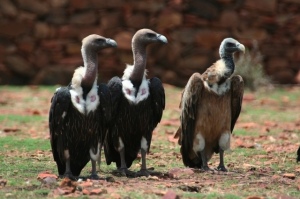Junagadh (Gujarat, India) Breeding centre starts Delivering
results
The government appears to be doing precious little for
improving the vulture count in the state. While their numbers have dropped to
1043 which is the lowest count registered so far, the government has so far
spent only Rs. 19.70 lakhs for their conservation in the last two years.
The count recorded in 2007 was 2539 and ever since then,
there has been a sharp decline. Their number was 1431 in 2008 and 1043 in May
2010.
In written reply to a question from Wakaner (Rajkot,
Gujarat, India) MLA Mohammed Javed Pirzada, environment and forest minister
Ganpat Vasava said that apart from an awareness campaign to conserve vultures,
the government has also started a vulture breeding centre at Sakkarbaugh Zoo in
Junagadh (Gujarat, India). In addition to this, the union government has banned
the use of Diclofenac treatment by vets, especially on cattle.
Vasava claimed that the centre at Sakkarbaugh Zoo has
started showing results in the form of a White Rumped vulture being bred successfully.
Two vultures have been born there in the last 2 years.
Officials said that vulture conservation in Gujarat has got
a major boost with the Bombay Natural History Society (BNHS) selecting Mahuva
(Rajkot, Gujarat, India) and Ahmadabad among the six provisional Vulture Safe
Zones (VSZ) in India.
A recent survey has indicated that the current state wide
estimated population of ‘critically endangered’ Gyps vultures is 938, White-
Rumped vultures is 577 and Long Billed Vultures is 361.
The survey has shown a reduction of 11.34 per cent in the
population of Gyps vultures between 2010 and 2013. In 2010, there were 1,065
Gyps vultures. In the survey carried last year, 97 Egyptian vultures and eight
Red headed vultures have been enumerated.
Courtesy:- Times Of India (Saturday, 23rd February,
2013).

.jpg)






